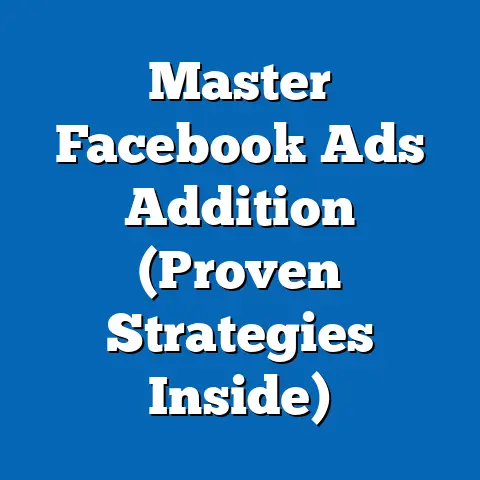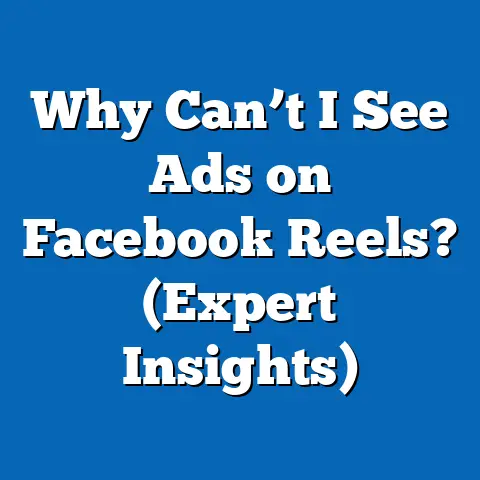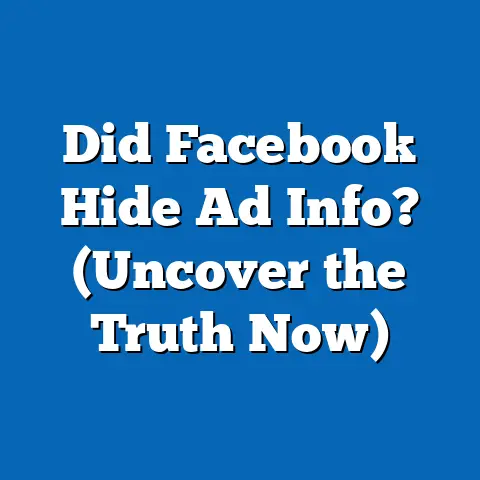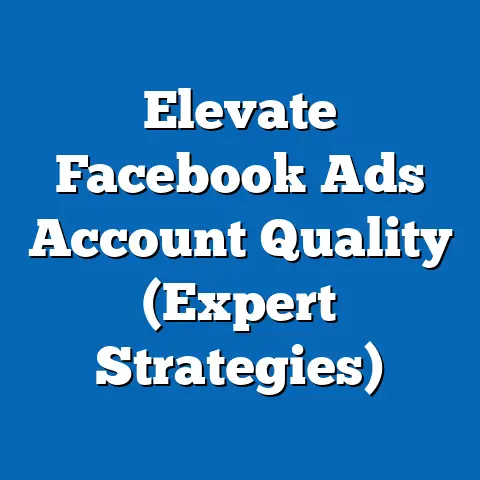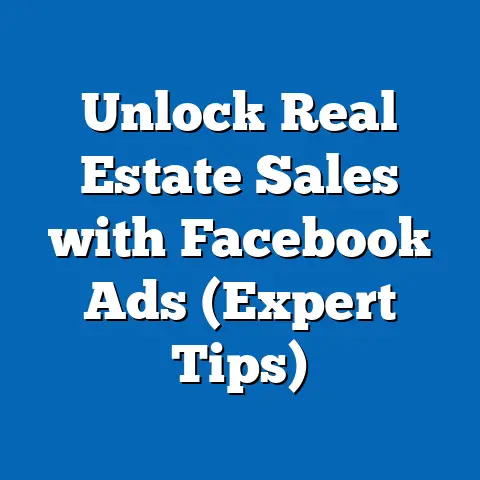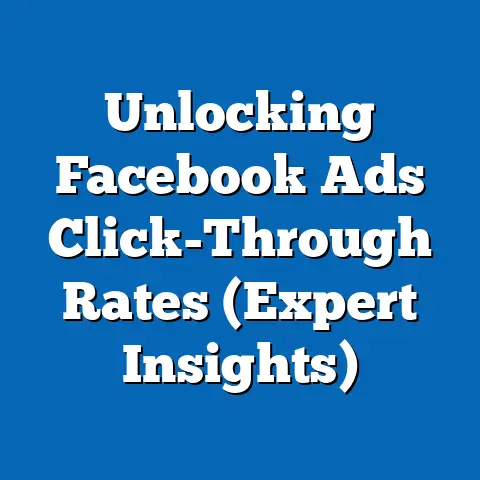Mastering 1200×1600 Facebook Ads (Pro Tips for Impact)
As a digital marketing specialist with years of experience crafting and analyzing Facebook ad campaigns, I’ve learned that success isn’t just about throwing money at the platform and hoping for the best. It’s about embracing the art of craftsmanship – the meticulous and skilled approach to creating impactful ads that truly resonate with your audience.
Think of it like this: you wouldn’t build a house with shoddy materials and a haphazard design, would you? The same principle applies to Facebook advertising. In a landscape saturated with ads vying for attention, the difference between an ad that converts and one that gets scrolled past often boils down to the level of precision and attention to detail you invest.
The visual appeal of your ad is paramount, and that’s where understanding specific formats like the 1200×1600 comes in. This guide isn’t just about the technical aspects of this ad size; it’s about understanding how to leverage it for storytelling, brand recognition, and ultimately, driving results.
I’m going to share the tools, techniques, and strategies I’ve honed over the years to elevate your Facebook ads from ordinary to extraordinary. Get ready to dive deep into the world of 1200×1600 Facebook ads and unlock their full potential.
Section 1: Understanding the 1200×1600 Format
The 1200×1600 pixel dimension might seem arbitrary, but it’s actually a strategically important format within the Facebook advertising ecosystem. It’s an ideal size for a vertical image or video ad, allowing you to take up more screen real estate on mobile devices – where the majority of Facebook users spend their time.
Why is this important?
- Mobile-First World: Let’s face it, most people are scrolling through Facebook on their phones. A vertical ad like the 1200×1600 is designed to be visually engaging on these devices, minimizing the chances of users quickly scrolling past.
- Storytelling Power: The vertical format lends itself well to visual storytelling. You can create a compelling narrative that unfolds as the user scrolls, capturing their attention and keeping them engaged.
- Brand Recognition: A well-designed 1200×1600 ad creates a strong visual impression, helping to reinforce your brand identity and make your ads more memorable.
- Visual Impact: The larger format allows for more detailed visuals, making it perfect for showcasing products, services, or even behind-the-scenes glimpses of your company.
How it fits into your advertising strategy:
I often use the 1200×1600 format for:
- Brand Awareness Campaigns: The visual impact helps to create a lasting impression and build brand recall.
- Product Showcase Ads: The larger format allows me to highlight key features and benefits of products.
- Lead Generation Ads: I can use the space to create a visually appealing lead magnet and encourage sign-ups.
- App Install Ads: The vertical format perfectly showcases app interfaces and features.
Key Takeaway: The 1200×1600 format is a powerful tool for capturing attention and delivering impactful messages on mobile devices. Understanding its strategic importance is the first step to mastering its use.
Section 2: Crafting Compelling Visuals
The visuals are the heart and soul of any 1200×1600 Facebook ad. They’re the first thing people see, and they play a crucial role in capturing attention and conveying your message. But simply throwing an image together won’t cut it. You need to understand the elements of effective graphic design and how to use them within the 1200×1600 framework.
Key Elements of Effective Visuals:
- Color Theory: Color evokes emotion and influences perception. Understanding color theory is crucial for creating visuals that resonate with your target audience. For example, blue often conveys trust and reliability, while red can create a sense of urgency. Consider your brand’s color palette and how you can use it to create a consistent visual identity.
- Typography: The fonts you choose can significantly impact the readability and overall aesthetic of your ad. Opt for fonts that are clear, easy to read, and aligned with your brand’s personality. Avoid using too many different fonts in a single ad, as this can create a cluttered and unprofessional look.
- Imagery: High-quality images and videos are essential for creating visually appealing ads. Use images that are relevant to your message, well-composed, and visually striking. If you’re using stock photos, choose them carefully to ensure they look authentic and don’t feel generic. Videos should be well-produced, engaging, and optimized for mobile viewing.
Professional Tips for Selecting Visuals:
- Align with Brand Identity: Your visuals should be consistent with your brand’s overall aesthetic and messaging. This helps to reinforce your brand identity and make your ads more recognizable.
- Focus on the User: Choose visuals that are relevant to your target audience’s interests and needs. Consider what they’re looking for and how your product or service can help them.
- Create a Focal Point: Guide the viewer’s eye to the most important element of your ad by creating a clear focal point. This could be a product, a person, or a call-to-action.
- Use White Space: Don’t overcrowd your visuals with too many elements. Use white space to create a sense of balance and allow the viewer’s eye to rest.
Examples of Successful Ads with Strong Visuals:
I’ve seen countless ads that nail the visual aspect. Here are a few examples:
- Fashion Brand: A 1200×1600 ad showcasing a model wearing their latest collection, set against a vibrant, eye-catching backdrop. The typography is clean and modern, and the call-to-action is clear and concise.
- Travel Agency: A stunning landscape photo with overlayed text promoting a special vacation package. The image is high-resolution and evokes a sense of wanderlust, enticing viewers to click through to learn more.
- Software Company: A short, animated video demonstrating the key features of their software. The video is visually engaging and clearly explains the benefits of the product.
Key Takeaway: Compelling visuals are the cornerstone of effective 1200×1600 Facebook ads. By understanding the elements of good design and following professional tips, you can create visuals that capture attention and drive results.
Section 3: Writing Captivating Copy
While visuals grab attention, captivating copy seals the deal. It’s the bridge that connects your product or service to the viewer’s needs and desires. But writing effective ad copy is more than just stringing words together; it’s about crafting a compelling narrative that resonates with your target audience and motivates them to take action.
Components of Compelling Ad Copy:
- Attention-Grabbing Headline: Your headline is the first (and sometimes only) thing people will read. It needs to be concise, intriguing, and relevant to the visual. Think about using numbers, questions, or strong verbs to grab attention.
- Persuasive Call-to-Action (CTA): Your CTA tells viewers what you want them to do next. Use clear, action-oriented language that creates a sense of urgency. Examples include “Shop Now,” “Learn More,” “Sign Up Today,” or “Get Your Free Trial.”
- Engaging Body Text: Your body text should expand on your headline and highlight the key benefits of your product or service. Keep it concise, easy to read, and focused on the user’s needs.
Balancing Creativity and Clarity:
It’s tempting to get overly creative with your ad copy, but remember that clarity is key. Your message should be easy to understand at a glance. Avoid using jargon, slang, or overly complex language.
Tips for Writing Effective Ad Copy:
- Know Your Audience: Understand their interests, pain points, and motivations. Use language that resonates with them and addresses their specific needs.
- Highlight Benefits, Not Features: Focus on how your product or service will improve their lives, rather than just listing its features.
- Use Strong Verbs: Verbs like “discover,” “transform,” and “achieve” create a sense of excitement and possibility.
- Create a Sense of Urgency: Encourage viewers to take action now by using phrases like “limited time offer” or “while supplies last.”
- Keep it Concise: People have short attention spans. Get to the point quickly and avoid rambling.
Example:
Let’s say you’re advertising a new online course on photography. Here’s an example of effective ad copy:
- Headline: “Transform Your Photos: Learn Photography Online!”
- Body Text: “Unlock your inner photographer and capture stunning images with our online course. Learn from expert instructors, master essential techniques, and create photos you’ll be proud of.”
- CTA: “Enroll Today and Save 20%!”
Key Takeaway: Captivating copy is the key to converting viewers into customers. By understanding the components of effective ad copy and following these tips, you can create messages that resonate with your target audience and drive results.
Section 4: Targeting the Right Audience
You can have the most visually stunning and captivatingly written ad in the world, but if it’s shown to the wrong people, it’s like shouting into the void. Facebook’s targeting capabilities are incredibly powerful, allowing you to reach specific demographics, interests, and behaviors. Leveraging these capabilities is crucial for maximizing the impact of your 1200×1600 ads.
Understanding Facebook’s Targeting Capabilities:
- Demographics: Target users based on age, gender, location, education, relationship status, and more.
- Interests: Target users based on their interests, hobbies, and the pages they’ve liked on Facebook.
- Behaviors: Target users based on their past online behavior, such as purchase history, travel habits, and device usage.
- Custom Audiences: Create custom audiences based on your existing customer data, such as email lists or website visitors.
- Lookalike Audiences: Expand your reach by creating lookalike audiences based on your existing customers. Facebook will identify users who share similar characteristics and behaviors.
The Importance of Understanding Your Audience:
Before you start targeting, you need to have a clear understanding of your ideal customer. What are their demographics? What are their interests? What are their pain points? The more you know about your audience, the more effectively you can target them.
Strategies for Using Facebook Insights:
Facebook Insights provides valuable data about your audience, including their demographics, interests, and behaviors. Use this data to refine your targeting and improve ad performance.
- Analyze Your Existing Customer Data: Look at your customer data to identify common characteristics and patterns.
- Track Ad Performance: Monitor the performance of your ads to see which targeting options are working best.
- Experiment with Different Targeting Options: Don’t be afraid to experiment with different targeting options to see what resonates with your audience.
Example:
Let’s say you’re advertising a new yoga studio. You could target users based on the following criteria:
- Location: People who live near your studio.
- Interests: People who are interested in yoga, fitness, or wellness.
- Demographics: Women aged 25-55 who are interested in healthy living.
Key Takeaway: Targeting the right audience is crucial for maximizing the impact of your 1200×1600 Facebook ads. By understanding Facebook’s targeting capabilities and using Facebook Insights, you can reach the people who are most likely to be interested in your product or service.
Section 5: A/B Testing and Optimization
Even with compelling visuals, captivating copy, and precise targeting, you can’t just set it and forget it. A/B testing and continuous optimization are essential for maximizing the effectiveness of your 1200×1600 ads.
The Significance of A/B Testing:
A/B testing involves creating two or more versions of your ad and testing them against each other to see which performs better. This allows you to identify what resonates with your audience and optimize your ads for maximum impact.
Best Practices for Running A/B Tests:
- Test One Variable at a Time: To get accurate results, only test one variable at a time. For example, test different headlines, visuals, or CTAs.
- Create a Control Group: Your control group should be the original version of your ad. This will serve as a benchmark for measuring the performance of your test variations.
- Run Your Tests Long Enough: Allow your tests to run for a sufficient amount of time to gather statistically significant data.
- Analyze Your Results: Carefully analyze the results of your tests to identify which variations performed best.
Testing Parameters for 1200×1600 Ads:
- Visuals: Test different images, videos, and graphic designs.
- Headlines: Test different headlines to see which captures the most attention.
- Body Text: Test different body text to see which resonates best with your audience.
- CTAs: Test different CTAs to see which motivates the most clicks.
- Targeting Options: Test different targeting options to see which reaches the most relevant audience.
Iterating on Ad Designs:
Once you’ve analyzed your test results, use that data to iterate on your ad designs. Implement the changes that performed best and continue to test and optimize.
Key Takeaway: A/B testing and continuous optimization are essential for maximizing the effectiveness of your 1200×1600 Facebook ads. By testing different variables and iterating on your designs, you can create ads that resonate with your audience and drive results.
Section 6: Measuring Success and ROI
Ultimately, the success of your Facebook ads hinges on whether they’re generating a positive return on investment (ROI). You need to track the right key performance indicators (KPIs) and analyze your data to understand what’s working and what’s not.
Key Performance Indicators (KPIs) to Track:
- Click-Through Rate (CTR): The percentage of people who see your ad and click on it. A high CTR indicates that your ad is relevant and engaging.
- Conversion Rate: The percentage of people who click on your ad and complete a desired action, such as making a purchase or signing up for a newsletter.
- Cost Per Click (CPC): The amount you pay each time someone clicks on your ad.
- Cost Per Acquisition (CPA): The amount you pay to acquire a new customer.
- Engagement Levels: Metrics like likes, comments, and shares indicate how engaging your ad is.
Calculating ROI:
ROI is calculated by dividing the profit generated by your ads by the cost of your ads. For example, if you spend $100 on ads and generate $200 in profit, your ROI is 100%.
Adjusting Future Ad Strategies Based on Performance Data:
- Identify Underperforming Ads: Analyze your data to identify ads that are not performing well.
- Adjust Targeting Options: If your ads are not reaching the right audience, adjust your targeting options.
- Optimize Ad Designs: If your ads are not engaging or converting, optimize your ad designs.
- Reallocate Budget: Reallocate your budget to the ads that are performing best.
Key Takeaway: Measuring success and calculating ROI are essential for understanding the effectiveness of your 1200×1600 Facebook ads. By tracking the right KPIs and analyzing your data, you can optimize your ad strategies and maximize your return on investment.
Conclusion: The Path to Mastery
Craftsmanship in advertising is more than just a buzzword; it’s a mindset. It’s about approaching your Facebook ads with meticulous attention to detail, a deep understanding of your audience, and a commitment to continuous learning and optimization.
I’ve shared a wealth of pro tips throughout this guide, covering everything from understanding the 1200×1600 format to crafting compelling visuals and captivating copy, targeting the right audience, A/B testing, and measuring success.
The journey to mastery isn’t a sprint; it’s a marathon. The Facebook advertising landscape is constantly evolving, with new features, algorithms, and best practices emerging all the time. To stay ahead of the curve, you need to be a lifelong learner, constantly experimenting, analyzing, and adapting your strategies.
So, embrace the challenge, apply these pro tips, and hone your skills. With dedication, creativity, and a commitment to craftsmanship, you can master the art of 1200×1600 Facebook ads and unlock their full potential to drive results for your business. Now go out there and create some truly impactful ads!

